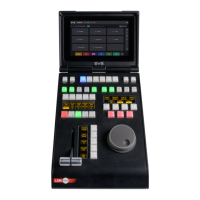
Do you have a question about the EVS LSM-VIA and is the answer not in the manual?
| Brand | EVS |
|---|---|
| Model | LSM-VIA |
| Category | Music Mixer |
| Language | English |
Provides a comprehensive overview of the LSM-VIA solution and its core features.
Details the essential steps for launching and configuring the LSM-VIA application.
Describes the physical layout and key areas of the LSM-VIA Remote Panel console.
Explains the functions and layout of the LSM-VIA Remote Panel's touchscreen interface.
Details the LSM-VIA Viewer interface, including its grids, panes, and application bar.
Explains the different channel control modes available for managing play channels.
Details how to control specific channels within PGM+PRV and Multi-PGM modes.
Describes the multi-operator mode, enabling independent work for multiple users.
Outlines the actions available from the main menu on the Remote Panel.
Details the functions available on the left operational block of the Remote Panel.
Details the functions available on the right operational block of the Remote Panel.
Details the functions available on the bottom operational block of the Remote Panel.
Explains how to map and use assignable shortcut keys for quick access to functions.
Describes the Live screen interface on the Remote Panel touchscreen.
Details how to reassign cameras to PGMs in different control modes.
Explains how to play, pause, and browse record trains using various controls.
Details procedures for synchronizing timecode and speed between record trains.
Covers adding, browsing, and deleting mark points on record trains.
Explains the hierarchical structure and numbering system used for clips.
Covers the functions and interfaces related to clips, including viewer and panel views.
Details operations for creating, deleting, copying, archiving, and searching clips.
Explains how to edit clips, including adding metadata, naming, and adjusting duration.
Describes various methods for loading, browsing, and playing clips.
Covers exporting clips and flagging them for archiving.
Explains the hierarchical structure and numbering system used for playlists.
Covers playlist functions, modes, and interface elements.
Details how to select, name, copy, delete, and export playlists.
Explains how to edit playlist elements, including moving, sorting, and adding cuts.
Covers applying transition effects and managing audio tracks within playlists.
Describes methods for loading, browsing, and playing playlists.
Details how to connect to and recall servers on the network.
Covers accessing, filtering, and loading network record trains.
Explains how to use the Shotbox for quick access and mapping of media.
Details the process of sending clips to other machines on the network.
Explains how to view and manage system notifications.
Details procedures for defining reference points and extracting system logs.